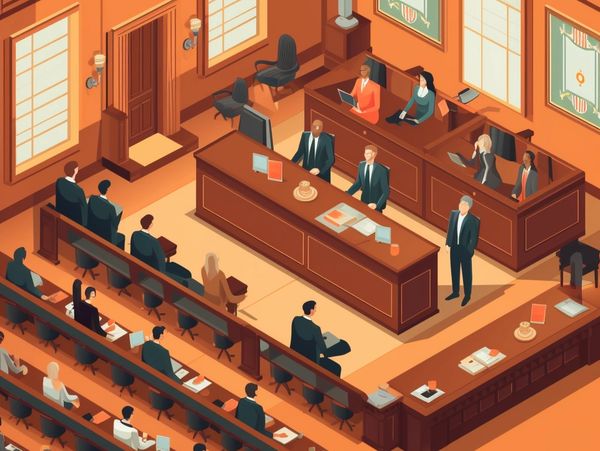Navigating the Complexities of Trial Presentations: Tips for Seamless Distribution and Compelling Disagreements
In the realm of lawful process, the art of trial presentation stands as a critical determinant of success. The complexities inherent in test presentations need a delicate balance of strategy, finesse, and skill.

Recognizing Test Goals
To effectively navigate a test, it is important to have a clear understanding of the objectives that need to be attained. Prior to tipping right into the courtroom, lawful groups should define their objectives and preferred end results. These purposes function as directing principles throughout the test, forming strategies and influencing decision-making procedures.
Comprehending test objectives entails an extensive evaluation of the case, lawful precedents, and the client's benefits. Trial Presentations. It needs a careful evaluation of the facts, recognizing crucial concerns, and expecting possible challenges. By setting particular and quantifiable objectives, attorneys can customize their presentations and arguments to align with the desired outcomes
Moreover, a clear grip of test purposes allows legal teams to prioritize proof, witnesses, and lawful debates efficiently. It permits the advancement of a coherent story that reverberates with the discretionary, enhancing the overall case discussion.

Organizing Evidence Efficiently
Having a clear understanding of trial goals lays the foundation for organizing evidence properly in legal process - Trial Presentations. By straightening the discussion of proof with the preferred outcomes of the trial, lawful teams can strengthen their arguments and enhance their persuasiveness. One vital element of organizing evidence is categorization. Organizing proof based upon styles or relevance to details lawful components can aid simplify the discussion and make intricate information a lot more absorbable for the judge or jury.
Another crucial element in arranging proof successfully is developing a sensible flow. Offering evidence in a systematic and consecutive fashion can aid build a compelling story that sustains the lawful debates being made. In addition, making use of aesthetic help such as timelines, charts, or graphs can further improve the organization of evidence and aid in making clear complicated partnerships or series of events.
In addition, guaranteeing that all proof presented is admissible and appropriate to the case is important. Inadmissible or irrelevant evidence can detract from the toughness of the disagreement and possibly hurt the reputation of the here and now event. As a result, a meticulous review and selection procedure must be embarked on to include only one of the most legally audio and impactful proof in the test presentation.
Crafting Persuasive Stories
Crafting compelling stories plays a critical role in presenting persuasive arguments during legal process. When creating a narrative for a trial discussion, it is vital to establish a clear storyline that highlights crucial factors and attaches them in a systematic way. By weaving with each other evidence, statement, and lawful arguments right into a cohesive and influential narrative, lawful specialists can efficiently support for their clients and enhance the possibility of a positive result in the court room.
Understanding Visual Aids
Effective use visual aids is essential to enhancing the effect and More hints clearness of test discussions. Aesthetic aids, when used purposefully, have the power to streamline intricate information, enhance key factors, and leave a long-term impact on the discretionary. To grasp visual aids in test presentations, it is important to make sure that they are clear, concise, and pertinent to the arguments being made.
When integrating aesthetic aids, such as charts, pictures, charts, or timelines, right into a test presentation, it is necessary to keep them aesthetically appealing yet expert. The visuals must enhance the verbal arguments, giving a graph of the details being talked about without frustrating the target market with unneeded information.
In addition, exercising with the visual help beforehand is important to make sure a seamless distribution during the trial. Familiarizing oneself with the web content, transitions, and timings of each visual help more information can assist maintain the circulation of the presentation and prevent technological glitches that might occur.
Supplying Impactful Closing Disagreements
An engaging closing disagreement serves as the conclusion of a trial discussion, encapsulating the core story and convincing the court and jury towards a beneficial decision. Begin by outlining the main arguments that sustain your customer's placement, stressing why the evidence offered throughout the trial sustains your narrative.
Furthermore, including emotional appeal can better reinforce your closing disagreement. Eventually, a well-crafted closing argument ought to leave a long lasting perception, engaging the court and court to rule in your client's favor.
Conclusion
To conclude, understanding test presentations involves recognizing objectives, organizing proof, crafting stories, making use of visual aids, and supplying impactful closing arguments. By executing these strategies effectively, lawyers can provide their instance flawlessly and make compelling arguments in the court. It is crucial to navigate the complexities of trial presentations with accuracy and skill to attain success in lawful procedures.
By straightening the discussion get redirected here of evidence with the preferred results of the test, lawful groups can enhance their debates and boost their persuasiveness (Trial Presentations). To understand visual aids in test discussions, it is critical to ensure that they are clear, succinct, and relevant to the arguments being made
An engaging closing debate offers as the conclusion of a test discussion, enveloping the core narrative and convincing the judge and jury in the direction of a positive choice. Begin by laying out the main arguments that support your client's placement, highlighting why the evidence provided throughout the trial sustains your story.In final thought, grasping trial discussions entails recognizing purposes, arranging evidence, crafting stories, using aesthetic aids, and supplying impactful closing debates.